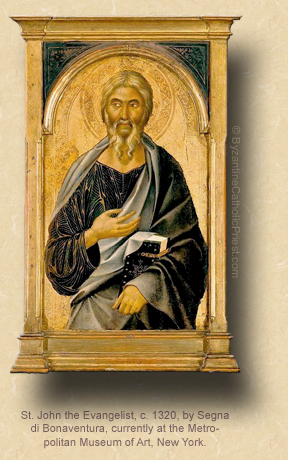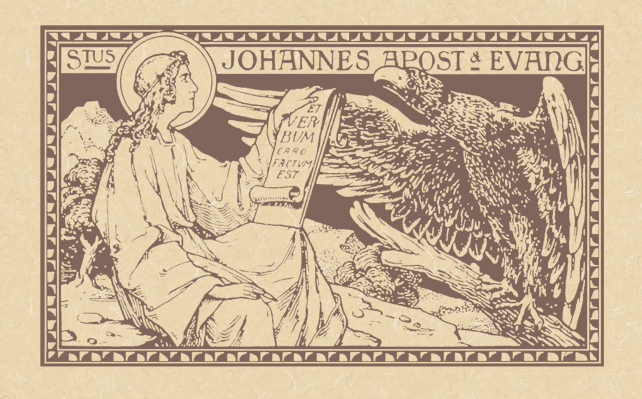Love.
The Tuesday after Epiphany; or, the Memorial of Saint Raymond of Penyafort, Priest.*
Lessons from the feria, according to the ordinary form of the Roman Rite:
• I John 4: 7-10.
• Psalm 72: 1-4, 7-8.
• Mark 6: 34-44.
|
When a Mass for the memorial is taken, lessons from the feria as above, or from the proper:
• II Corinthians 5: 14-20.
• Psalm 103: 1-4, 8-9, 13-14, 17-18.
• Luke 12: 35-40.
…or, any lessons from the common of Pastors for One Pastor.
|
The First Day after the Epiphany.
Lessons from the proper as on Epiphany, according to the extraordinary form of the Roman Rite:
• Isaiah 60: 1-6.
• [Gradual] Isaiah 60: 6, 1.
• Matthew 2: 1-12.
FatherVenditti.com
|
 3:29 PM 1/7/2020 — We’ve discussed today’s Gospel lesson—Mark’s account of the feeding of the multitude on the hillside—many times; so, I would like to offer a reflection on today’s first lesson from the First Epistle of Saint John, which—on the surface—seems to be just a touchy-freely love-fest about “love,” whatever that means. Why don’t we try to take a more intelligent and historical look at this passage? 3:29 PM 1/7/2020 — We’ve discussed today’s Gospel lesson—Mark’s account of the feeding of the multitude on the hillside—many times; so, I would like to offer a reflection on today’s first lesson from the First Epistle of Saint John, which—on the surface—seems to be just a touchy-freely love-fest about “love,” whatever that means. Why don’t we try to take a more intelligent and historical look at this passage?
The Apostle and Evangelist John was a native of Bethsaida in Galilee, on the shores of the Sea of Tiberias. His brother was Saint James the Greater, and his parents were Zebedee and Salome. They were a well-to-do family of fishermen when they met our Lord. John had been a disciple of John the Baptist, and in his Gospel he tells the story of how he and Andrew had been with him when he was baptizing one day at the River Jordan when Jesus walked by. The Baptist pointed to our Lord and said “Behold the Lamb of God” (John 1: 36). The Evangelist then goes on to tell us: "The two disciples heard him say it, and they followed Jesus. Turning, and seeing them follow him, Jesus asked, What would you have of me? Rabbi, they said (a word which means Master), where dost thou live? He said to them, Come and see; so they went and saw where he lived, and they stayed with him all the rest of the day, from about the tenth hour onwards” (John 1: 37-39 Knox).
We don’t know what they talked about all that first day with our Lord, but it must have made an impression because it was not long after that that John and his brother were repairing nets with their father when Jesus returned the favor and visited them, saying only two words: “Follow me.” And, as you know, they did, and never looked back. We know that their mother, Salome, also went along, and was with our Lord at the very end, standing by the cross with our Blessed Mother, and was present at the empty tomb on Easter Sunday morning.
James and John, along with Peter, were our Lord’s three favorites, present with Him at the Transfiguration, and again at the Agony in the Garden. James was the first of the Apostles to die for our Lord, beheaded by Herod. John, being the youngest of the Apostles, would eventually see all of his fellow Apostles shed their blood for our Lord.  Eventually he settled in Ephesus where he wrote his Gospel at the request of the bishops of Asia, who were battling at the time the heresy of the Ebionites, who were preaching that Jesus had no existence before Mary; that’s why John’s Gospel begins the way it does: “In the beginning was the Word, and the Word was with God, and the Word was God” (John 1: 1). Eventually he settled in Ephesus where he wrote his Gospel at the request of the bishops of Asia, who were battling at the time the heresy of the Ebionites, who were preaching that Jesus had no existence before Mary; that’s why John’s Gospel begins the way it does: “In the beginning was the Word, and the Word was with God, and the Word was God” (John 1: 1).
When the Emperor Domitian stirred up the second persecution, John was exiled to the Island of Patmos, where wrote the Book of Revelation. After Domitian was assassinated, the senate annulled all of his decrees, and John returned to Ephesus, where he assumed governance over all the Churches of Asia, eventually writing three Epistles which are preserved for us in the New Testament, and where he lived until an extreme old age, dying in the sixty-eighth year after our Lord Ascension. In his commentary on the Epistle to the Galatians, Saint Jerome gives us the only glimpse we have of John during the last years of his life:
The Blessed Evangelist John lived at Ephesus down to an extreme old age, and, at length, when he was with difficulty carried to the Church, and was not able to exhort the congregation at length, he was used simply to say at each meeting, My little children, love one another. At last the disciples and brethren were weary with hearing these words continually, and asked him, Master, why do you always say the same thing? Whereto he replied to them, Because it is the Lord's commandment; and if you did nothing more, it would suffice (Book 3, ch. 6).
In fact, throughout his Gospel John never mentions himself by name, but instead refers to himself as “the disciple whom Jesus loved.” Our Lord loved him because he loved our Lord. After our Lord called him with a simple “Follow me,” John did exactly that, and never looked back; and, as He hung upon the cross, our Lord entrusted His own Blessed Mother to John to care for as if She was his own.
And there you have the two secrets to becoming wrapped in the love of God: following Him without hesitation, and loving His Blessed Mother.

* In the ordinary form, the days between Epiphany and the Baptism of the Lord are considered ferias of the Christmas season; by contrast, in the extraordinary form, Christmastide ends with Epiphany, and the Epiphany season begins.
Born in Barcelona, Penyafort (1175-1275) was the third superior general of the Dominican Order. He is famous for his efforts to abolish slavery. He wrote five books of Decretals which were instrumental in the development of canon law. His most famous work is the Summa de Casibus Penitentiæ, which remians to this day a valuable tool to guide priests in the administration of the sacrament of Confession.
|

